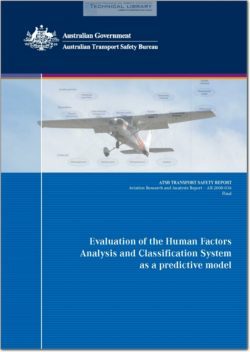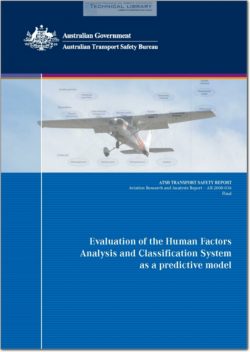ATSB-AR-2008-036

- Version
- 176 Downloads
- 2.39 MB File Size
- 1 File Count
- August 9, 2016 Create Date
- August 9, 2016 Last Updated
Evaluation of the Human Factors Analysis and Classification System as a Predictive Model

The Human Factors Analysis and Classification System (HF ACS) is a hierarchical taxonomy that
describes the human factors that contribute to an aviation accident or incident that is based on a chain—
of—events theory of accident causation and was derived from Reason’s (1990) accident model.
The objectives of this exploratory study were to identify relationships between the factors of the
HFACS taxonomy and to assess the usefulness of HFACS as a predictive tool. The associations found
in this study may assist investigators in looking for associated factors when contributing factors are
found. Also, when using the HFACS taxonomy to identify areas for intervention, the relationships
found may also guide intervention in associated areas for a holistic, systems approach to improvement.
This exploratory study found a number of strong positive relationships between factors at different
levels of the model. However, based on the amount of variation explained by the logistical regression
statistical models, it appears that HFACS is a more effective predictive framework when used to
predict unsafe acts than when used to predict higher levels within the taxonomy.
The Australian Transport Safety Bureau (ATSB) formalised the concept of outside influences and
added five factors within this grouping to the HFACS model in this study. The outside influences
factors proved to be important additions to the HFACS model as they were associated with factors at
all levels of the HAFCS taxonomy.
The results have also shown that it is not always the case that higher—level factors predict only the
lower—level factors directly below them. For example, inadequate supervision predicted precondition
for unsafe acts, such as adverse mental states and crew resource management issues, as well as skill-
based errors (two levels down).
| File | Action |
|---|---|
| ATSB-AR-2008-036 Evaluation of the Human Factors Analysis and Classification System as a Predictive Model.pdf | Download |
Comment On This Post